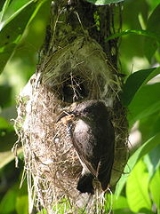
Seychelles Sunbird
Encyclopedia
The Seychelles Sunbird is a small passerine from the family of sunbird
s. It is named after the French explorer Jean-Jacques Dussumier
. It is native to the Seychelles
, where it is known as kolibri in Seychellois Creole
. This bird is variously placed in the Cinnyris genus.
Sunbird
The sunbirds and spiderhunters are a family, Nectariniidae, of very small passerine birds. There are 132 species in 15 genera. The family is distributed throughout Africa, southern Asia and just reaches northern Australia. Most sunbirds feed largely on nectar, but also take insects and spiders,...
s. It is named after the French explorer Jean-Jacques Dussumier
Jean-Jacques Dussumier
Jean-Jacques Dussumier was a French voyager and merchant from Bordeaux. He is known as a collector of zoological species from South Eastern Asia and regions around the Indian Ocean between 1816 and 1840. These collections were later studied and classified by French zoologists such as Georges...
. It is native to the Seychelles
Seychelles
Seychelles , officially the Republic of Seychelles , is an island country spanning an archipelago of 115 islands in the Indian Ocean, some east of mainland Africa, northeast of the island of Madagascar....
, where it is known as kolibri in Seychellois Creole
Seychellois Creole
Seychellois Creole, also known as Kreol or Seselwa, is the French-based creole language of the Seychelles. It shares official language status with English and French ....
. This bird is variously placed in the Cinnyris genus.

